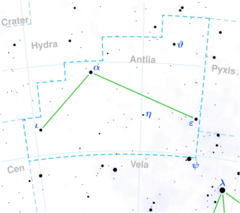Astronomy:Zeta2 Antliae
| Observation data Equinox J2000.0]] (ICRS) | |
|---|---|
| Constellation | Antlia |
| Right ascension | 09h 31m 32.15879s[1] |
| Declination | −31° 52′ 18.5989″[1] |
| Apparent magnitude (V) | 5.91[2] |
| Characteristics | |
| Spectral type | A9 IV[3] |
| U−B color index | +0.16[2] |
| B−V color index | +0.23[2] |
| Astrometry | |
| Radial velocity (Rv) | +19.8 ± 1.6[4] km/s |
| Proper motion (μ) | RA: -47.968 ± 0.162[5] mas/yr Dec.: -8.784 ± 0.179[5] mas/yr |
| Parallax (π) | 8.4565 ± 0.1075[5] mas |
| Distance | 386 ± 5 ly (118 ± 2 pc) |
| Absolute magnitude (MV) | +0.44[6] |
| Details | |
| Mass | 1.71[7] M☉ |
| Radius | 4.22[7] R☉ |
| Luminosity | 49.5[7] L☉ |
| Surface gravity (log g) | 3.42[7] cgs |
| Temperature | 7,455[7] K |
| Other designations | |
| Database references | |
| SIMBAD | data |
Zeta2 Antliae is the Bayer designation for a star in the southern constellation of Antlia, the air pump. With an apparent visual magnitude of 5.91,[2] it is a relatively faint star that requires dark suburban skies for viewing with the naked eye. Parallax measurements show it to be located at a distance of roughly 386 light-years (118 parsecs) from Earth.[1]
The spectrum of this star matches a stellar classification of A9 IV,[3] where the luminosity class of IV indicate that this is a subgiant star that is evolving away from the main sequence as the supply of hydrogen at its core is becoming exhausted. This is catalogued as an Am star, which means it is a chemically peculiar star that shows strong indications of certain trace metals in its spectrum.[6] The chemical peculiarity is now considered doubtful.[9]
References
- ↑ 1.0 1.1 1.2 van Leeuwen, F. (November 2007), "Validation of the new Hipparcos reduction", Astronomy and Astrophysics 474 (2): 653–664, doi:10.1051/0004-6361:20078357, Bibcode: 2007A&A...474..653V.
- ↑ 2.0 2.1 2.2 2.3 Mendoza, E. E.; Gomez, V. T.; Gonzalez, S. (June 1978), "UBVRI photometry of 225 Am stars", The Astronomical Journal 83: 606–614, doi:10.1086/112242, Bibcode: 1978AJ.....83..606M.
- ↑ 3.0 3.1 Houk, Nancy (1979), Michigan catalogue of two-dimensional spectral types for the HD stars, 3, Ann Arbor, Michigan: Dept. of Astronomy, University of Michigan, Bibcode: 1982mcts.book.....H.
- ↑ Gontcharov, G. A. (November 2006), "Pulkovo Compilation of Radial Velocities for 35 495 Hipparcos stars in a common system", Astronomy Letters 32 (11): 759–771, doi:10.1134/S1063773706110065, Bibcode: 2006AstL...32..759G.
- ↑ 5.0 5.1 5.2 Brown, A. G. A. (August 2018). "Gaia Data Release 2: Summary of the contents and survey properties". Astronomy & Astrophysics 616: A1. doi:10.1051/0004-6361/201833051. Bibcode: 2018A&A...616A...1G. Gaia DR2 record for this source at VizieR.
- ↑ 6.0 6.1 Hauck, B.; Curchod, A. (December 1980), "Properties of AM stars in the Geneva photometric system", Astronomy and Astrophysics 92 (3): 289–295, Bibcode: 1980A&A....92..289H.
- ↑ 7.0 7.1 7.2 7.3 7.4 Stassun K.G. (October 2019), "The revised TESS Input Catalog and Candidate Target List", The Astronomical Journal 158 (4): 138, doi:10.3847/1538-3881/ab3467, Bibcode: 2019AJ....158..138S.
- ↑ "zet02 Ant". SIMBAD. Centre de données astronomiques de Strasbourg. http://simbad.u-strasbg.fr/simbad/sim-basic?Ident=zet02+Ant.
- ↑ Renson, P.; Manfroid, J. (May 2009), "Catalogue of Ap, HgMn and Am stars", Astronomy and Astrophysics 498 (3): 961–966, doi:10.1051/0004-6361/200810788, Bibcode: 2009A&A...498..961R.
External links
 |


